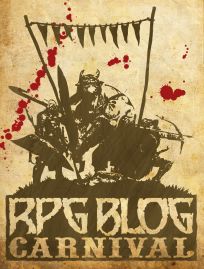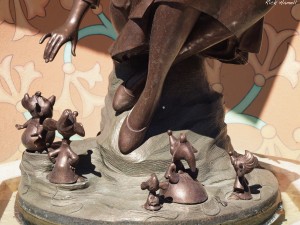
One of the biggest things that GM’s overlook in their game world is transitions in time and how if affects the world around the player characters. IE, What happens to the PC’s favorite Inn or Tavern after they have been gone for a while? Maybe the PCs heard some rumors in the inn that took them on a world saving journey that lasted many years? What happened to the inn now that they’re back in town? This month’s article for the RPG Blog Carnival is all about “Transitions.”
You can likely see transitions in your own neighborhood. Old buildings have been torn down or updated. New buildings have come in. Restaurants and stores have gone out of business and new ones have opened up. For a bit of reality in a gaming world it makes sense to add such transitions. They can simply be flavor for your game world or can be important plot points for further adventure.
A good example of an extreme version of this in fantasy literature is the last chapter of J.R.R. Tolkien’s “The Return of the King” simply called “The Scouring of the Shire.” When the four Hobbits return home to The Shire, they find that it’s been taken over by Men from the South led by the former wizard Saruman who is living in Bag End. The formerly peaceful Shire is full of pollution. The Hobbits as a race are effectively enslaved and generally unhappy in sharp contrast to how peaceful and serene it was when they left. The Hobbits, specifically Merry and Pippen, rally The Shire to battle. They kick the strangers out in the Battle of Bywater, also known as the last battle in the War of the Ring. Saruman, the formerly powerful wizard, is killed by his servant Wormtounge (who had been poisoning the mind of the King of Gondor,) who in turn is slain by an arrow. Afterwards the Shire goes back to it’s original happy and serene place as the Hobbit race is once again free.
In my own game world I have a building that is the Orphanage of Talric. It is a huge two story stone building. A grand stair case from the front door leads to the second floor. On the west wing of the ground floor are class rooms. The east wing is kitchen, dining area, and temple to Talric. A small storage closet serves as armory, mostly practice weapons.
The second floor is dormitories. Orphans share rooms in the west wing, while the teachers and staff each have their own room in the west wing. There are also rooms for visitors and dignitaries, or even road weary travelers who need a place to stay the night. There is also a “hidden” basement area that is mostly used for storage.
This location has served in my game for nearly ten years. During that time I have built up quite a history for it as it’s been through multiple transitions. The building was originally built 500 years ago (in game time,) as the Mayor’s house for the town. When the Black Hand armies came through 200 years ago, they took over the building and made it the regional Headquarters for their army. As part of the offense against the Black Hand by the Solar Empire, it was captured by a group of adventurers in a daring midnight raid two years later. The leader of this party was a Paladin of Talric who built a basic temple inside to worship at. The Solar Empire used it as their own forward Headquarters during this time.
The temple attracted Paladins and Clerics of Talric to the area who ended up being instrumental in turning back a last ditch attempt to break the Empire’s defensive lines. This effectively collapsed the Black Hand’s offensive, but the war lasted another three years as lost territory was reconquered. During that time the temple took in so many war orphans that is gradually took over the entire building as the front lines moved forward and it was no longer needed as headquarters.
Since then the building has housed Orphans from all over the Empire and has been a central location for many adventurers. Player Characters lived and met each other in the orphanage. Orphans have been stolen in the dead of night for nefarious purposes. The hidden basement houses supplies left over from the war, among these an powerful artifact wanted by a mysterious Cult. The former mayor’s family have fallen on hard times, but they do have one thing, the original deed to the house and they want it back. Goblin raiders driven from the mountains by an early snow storm attempted to attack the Orphanage.
The possibilities have been endless for this building because I sat down to think about it’s transition through the decades. This can be done for any building or location. Not just over hundreds of years, but even over a few months. Keep in mind that the one constant is change, and your game world should reflect this to be as believable as possible.
For those who run dungeons in their fantasy games, it’s good to think what happened to the dungeon after the players went through it. Perhaps that colony of giant bees take over the entire complex now that there are no larger creatures to hold them back? Maybe the PC’s battle through the dungeon severely damaged it and has caused a partial collapse that reveals another level or two? Or have bandits discovered the abandoned dungeon and turned it into their hideout?
If you need a little help, I created the below chart to help you think about transitions. Roll a D20 to see what event happened at the location. From there you should be able to build a back story and likely an adventure or two.
Transitions Chart
1 – cataclysm, nothing is left to even rebuild
2 – devastated, in ruins no one cares to rebuild
3 – recently suffered a disaster, main NPC’s maybe dead or missing
4 – recently suffered a disaster, but everyone is OK, rebuilding in progress
5 – famine or drought is causing people to move on
6 – sold, given away, taken over by some one else.
7 – razed to make way for a new construction project
8 – NPC has died or left unexpectedly
9 – PCs relative, patron, or friend has shown up unexpectedly
10 – increase in taxes causes a slow down in business or traffic
11 – severe weather causing flooding or other damage
12 – NPC has recently come into a huge amount of money and is making modifications or repairs
13 – Long lost relative joins the family business
14 – A party of adventurers had a fight, causing huge amount of damage
15 – Raided by evil (humans, creatures, elves, tax collectors)
16 – New Permit process affects business
17 – Nobility have discovered the location, their money and influence is pushing out the poorer folks
18 – Owner approaches the PCs to invest in their business or company
19 – Main trade route has moved causing a drop in business
20 – Nothing, all is well just as the PCs last saw it. Or is it?
Be sure to modify as needed for your game world.
Please let me know what you think of this article. I’d love to hear any comments, ideas, or suggestions!






